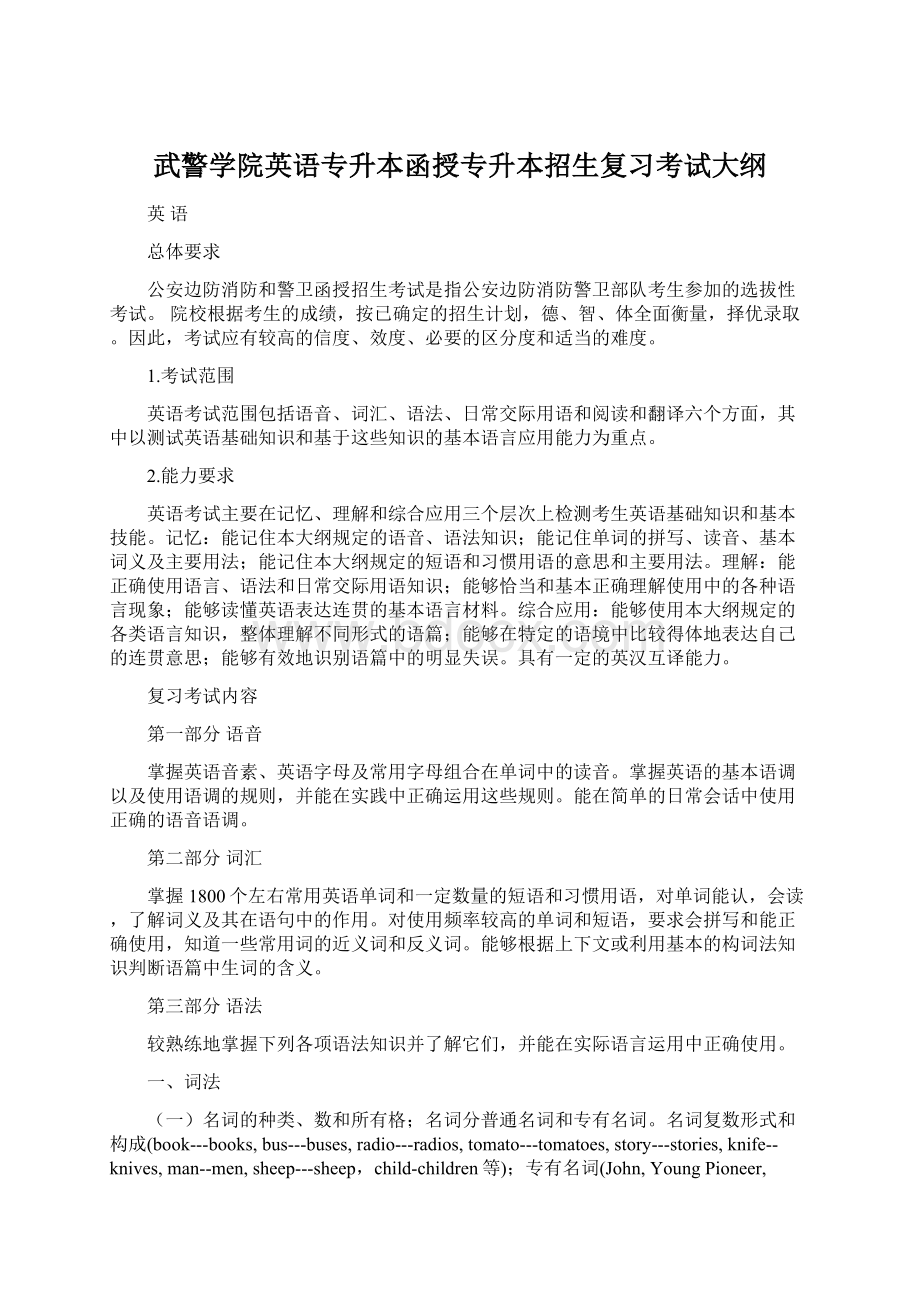武警学院英语专升本函授专升本招生复习考试大纲.docx
《武警学院英语专升本函授专升本招生复习考试大纲.docx》由会员分享,可在线阅读,更多相关《武警学院英语专升本函授专升本招生复习考试大纲.docx(26页珍藏版)》请在冰豆网上搜索。

武警学院英语专升本函授专升本招生复习考试大纲
英语
总体要求
公安边防消防和警卫函授招生考试是指公安边防消防警卫部队考生参加的选拔性考试。
院校根据考生的成绩,按已确定的招生计划,德、智、体全面衡量,择优录取。
因此,考试应有较高的信度、效度、必要的区分度和适当的难度。
1.考试范围
英语考试范围包括语音、词汇、语法、日常交际用语和阅读和翻译六个方面,其中以测试英语基础知识和基于这些知识的基本语言应用能力为重点。
2.能力要求
英语考试主要在记忆、理解和综合应用三个层次上检测考生英语基础知识和基本技能。
记忆:
能记住本大纲规定的语音、语法知识;能记住单词的拼写、读音、基本词义及主要用法;能记住本大纲规定的短语和习惯用语的意思和主要用法。
理解:
能正确使用语言、语法和日常交际用语知识;能够恰当和基本正确理解使用中的各种语言现象;能够读懂英语表达连贯的基本语言材料。
综合应用:
能够使用本大纲规定的各类语言知识,整体理解不同形式的语篇;能够在特定的语境中比较得体地表达自己的连贯意思;能够有效地识别语篇中的明显失误。
具有一定的英汉互译能力。
复习考试内容
第一部分语音
掌握英语音素、英语字母及常用字母组合在单词中的读音。
掌握英语的基本语调以及使用语调的规则,并能在实践中正确运用这些规则。
能在简单的日常会话中使用正确的语音语调。
第二部分词汇
掌握1800个左右常用英语单词和一定数量的短语和习惯用语,对单词能认,会读,了解词义及其在语句中的作用。
对使用频率较高的单词和短语,要求会拼写和能正确使用,知道一些常用词的近义词和反义词。
能够根据上下文或利用基本的构词法知识判断语篇中生词的含义。
第三部分语法
较熟练地掌握下列各项语法知识并了解它们,并能在实际语言运用中正确使用。
一、词法
(一)名词的种类、数和所有格;名词分普通名词和专有名词。
名词复数形式和构成(book---books, bus---buses, radio---radios, tomato---tomatoes, story---stories, knife--knives, man--men, sheep---sheep,child-children等);专有名词(John,Young Pioneer,America等);名词的所有格 (Mike’s father,students’bedroom, a map of the world等);不可数名词 (water, tea, paper 等);不可数名词量化表示法 (例a piece of paper,acupofteaandabowlofwater )。
(二)冠词(a/an, the )的基本用法;
(三)代词的用法:
人称代词的主格和宾格(we, you,they,she;us, you,them,her 等);形容词性物主代词 (my , your ,her ,his 等);名词性物主代词 (ours,yours,mine,his,hers, theirs 等);指示代词 (this , that ,these , those 等);不定代词 (some, any 等);疑问代词(what , who ,whose , which,why,where,when等);关系代词(who,whom,whose, which, that, as 等);关系副词(when,where,why)等。
(四)“it”作引导词,非人称代词和在强调句型中的用法;
ItisimportantforustolearnEnglish.
Theyfinditinterestingtodothisexperiment.
Itwasat11o’clockthattheycameback.
(五)数词的基本用法;
基数词的构成及其基本用法;序数词的构成及其基本用法;加、减、乘、除运算表示法;时间、年代、年龄表示法
(六)形容词和副词的用法:
形容词的基本用法(作定语、表语、补足语等)和副词的基本用法(表示时间、地点、方式、程度和频度)。
形容词和副词比较级和最高级的构成(-er, -est;more, the most 以及特殊的形式)基本句型:
----as +原级形式+as---not as /so+原级形式+as---比较级形式+than---the 比较级形式the比较级形式 No sooner---than---the+最高级形式+--in/of---
(七)动词的种类、时态、语态和非谓语动词;
1.动词的种类
(1)行为动词或实义动词
(2)连系动词( be, look, turn, get, become, etC.
(3)助动词 (be, do, have, shall, will, etc )
(4)情态动词 (can, may, must, need, etc )
2.时态
(1)一般现在时
He gets up at six o’clock in the morning.
She doesn’t speak Chinese.
The earth goaround the sun.
(2)一般过去时
He was in Grade Two last year.
She got up five yesterday morning.
(3)一般将来时
Shall we go to your school tomorrow?
They will be free next week.
She is going to do her homework this evening.
(4)现在进行时
He is doing his homework now.
We are playing football on the playground now.
(5)过去进行时
They were singing when I came here.
They have lived there for five years.
(6)现在完成时
He has already finished his homework.
They have lived there for five years.
(7)过去完成时
We had learned 1000 words by the end of last year.
When I got there she had gone already.
(8)过去将来时
She said she would go to Beijing the next day.
Tom said he was going to see his uncle.
3.语态:
分为主动语态和被动语态。
(1)一般现在时的被动语态
English is taught in that school.
(2)一般过去时的被动语态
The song was written by that singer.
(3)一般将来时的被动语态
The work has been done already.
(4)带有情态动词的被动语态
She must be sent to hospital at once.
4.非谓语动词的基本用法
(1)动词不定式的用法
①作主语
To learn a foreign language is not easy.
It is not easy to learn a foreign language.
②作宾语
They began to read.
③作宾语补足语
Jim asked me to help him with his lessons.
Try to make him stay with us.
④作定语
I have an important meeting to attend.
⑤作表语
She went to see her grandma yesterday.
⑥作表语
She went to see her grandma yesterday.
⑦用在how,when, where,what, which 等之后
I don’t know how to us a computer.
Do you know when to start?
He didn’t know what to do next.
(2)动名词的用法
①作主语
Seeing is believing.
It is useless arguing about it.
②作表语
Her job is looking after children
③作宾语
I like singing.
He suggested having a party at the weekend.
④作定语
There is swimming pool in our school.
This is a sleeping car.
(3)分词的用法
①作表语
The situation is encouraging
The boy was greatly encouraged.
②作定语
Our country is a developing country.
The car ran along the school gate.
③作宾语补足语
I saw them waiting at the school gate
I saw the door closed.
④作状语
Hearing the noise,they immediately stopped talking.
Seen from a distance, the mountain looked like an elephant.
(八)常用介词和连词掌握词汇表中所列介词和连词的用法。
二、句法
(一)句子种类
1.陈述句(肯定式与否定式)
They go to school at seven in the morning.
She isn’t a worker.
2.疑问句
(1)一般疑问句
Are you a teacher?
Does she speak English?
(2)特殊疑问句
When were you born?
Why do you study English?
(3)反意疑问句
He comes here one or that one?
Does she life math or Chinese?
(4)选择疑问句Do you want this one or that one ?
Does she like math or Chinese?
3.祈使句
Come here,please!
Don’t do anything like that!
4.感叹
What a fine day it is today!
How fine it is today!
5.并列句
I turned on the TV and we sat down and watched it.
6.复合句
(1)名词性从句:
主语从句:
What he said is right.
Whether she will come or not is still a question.
宾语从句:
I don’t know why he left without saying a word.
He said(that)h